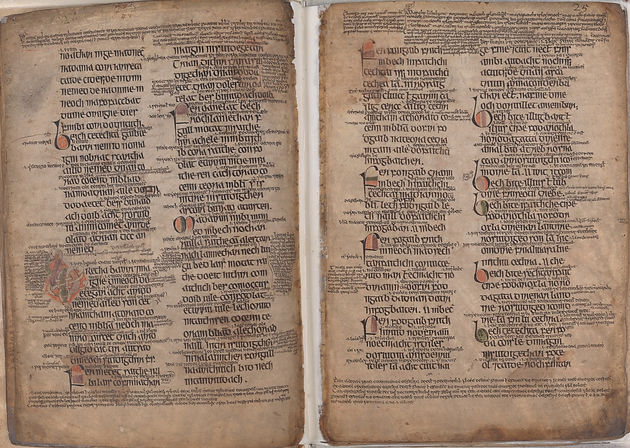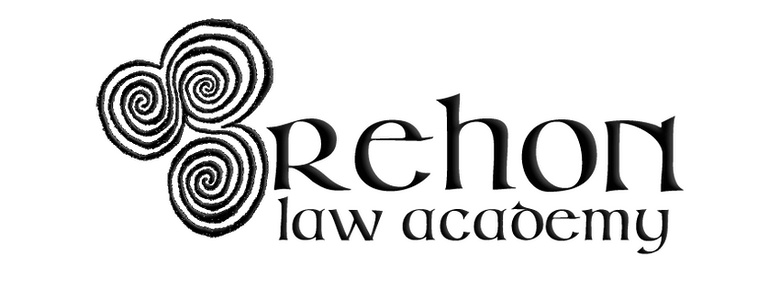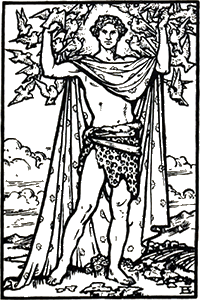The ancient Irish laws were recorded in manuscripts by the Brehons (judges). While much of this knowledge has been lost due to the brutal British colonisation of Ireland, what remains reveals an interesting keyhole glimpse into the everyday life, aspirations, and order of early Irish society.
The law tracts contain details for how to legally address many of the intricacies – and the calamities – of day to day life in a surprising amount of detail.
Still, commenters have noted that these detailed law tracts only provided a mere basic guideline to aid in the memory recall of the learned legal scholars, so we can assume the law was even more developed and fleshed out than we can currently piece-together.
The law tracts that have come down to us contain a wealth of information about the sort of issues which the Brehons, and, by proxy, the people held to be important. So important that customs and laws developed around them.
It might come as a surprise to find that the early Irish had the prevention of the exploitation of individuals who suffered with a disability or mental health issues in their minds, but we know this is the case from the research of great scholars on early Irish law who translated the the law tracts. Foremost among these living scholars is Dr. Fergus Kelly who deals with these topics in his book Early Irish Law, and his article 'Medicine and Early Irish Law'.
Kelly notes that a manuscript called Do brethaib gaire deals with the kin's obligation to care for its members who are insane, aged or suffering from physical disabilities. (Kelly, p.93).
The law-texts sometimes include the esconn, as 'one whose sense has departed' (i.e. a senile person) among those who are legally incapable on account of their mental condition. According to Berrad Airechta manuscript the evidence of a person who is too old is invalid, because 'his memory does not reach far'.
While the legal manuscripts do not prescribe any treatments, they do account for such people in a way that seemingly aimed at giving a greater protection to those who might not have the full mental or physical ability to protect themselves. This was formulated through the legal principle that
“the rights of the insane precede all other rights.”
The principle was that such individuals should not be exploited, exploitation was, therefore, essentially outlawed. Fines were levied on anyone who would even mock those with mental or physical disabilities.

Individuals with mental disabilities were considered to be legally incapable, and in this way were viewed no differently than a woman with no standing, a child, an older son who is still dependent on his father for support, or, for that matter, a slave or an un-ransomed captive.
In other words, such individuals were classed as legal dependents or incompetent whose legal protections and obligations rested with their legal guardians (Kelly, Early Irish Law p.68).
The early Irish distinguished between different types of mental illness, Kelly lists three of these: 1. drúth, someone who is mentally retarded, 2. mer, someone who is deranged, and 3. dásachtach, someone who is violently insane.
1. The word drúth, ‘someone who is mentally retarded’, is still found in modern Irish to mean an irresponsible person, imbecile, jester, buffoon. In other modern usages it can mean unchaste, or someone who is wanton, merciless, perhaps this related to what we would refer to as a psychopath today?
2. The old Irish word mer gives us the modern Irish word mearú, meaning derangement, distraction, bewilderment, confusion; mental aberration, wandering, hallucination; mirage.
3. Kelly gives a translation of the word dásachtach as meaning ‘someone who is violently insane’. The word is still found in the Irish language today where it is taken to mean: daring, madness, fury, audacious, mad, furious.
Any contracts entered into with persons of unsound mind would be prima facie, automatically invalid. Any persons who entice a drúth into such a bargain is liable to pay a fine. Any person inciting a drúth to commit a crime was liable themselves to pay the penalties.
However, the insane person is also exempt from giving evidence and their testimony has no standing at law. Instead, their legal standing rested entirely with their legal guardian who would speak for them at court and be liable for their offences. If either partner in a marriage becomes insane, the other is entitled to a separation.
In such small communities of tightly knit families, the tribe had a responsibility to their kin who happened to suffer from mental derangement, but they also had a duty to protect themselves and others from the dangerously insane. For this reason a dásachtach could be tied up and forcibly detained if they posed a threat to others. This is unthinkable by today’s standards, but it’s important to appreciate that this was done out of compassion, ignorance, and a lack of alternatives. A man who impregnates a mentally unsound woman, whether by rape or persuasion, would find himself fully liable for the financial and social responsibility for raising any offspring.
A man who impregnates a mer is solely responsible for rearing the offspring, and a sane woman who bears a child to a dúth is similarly obliged to rear it unaided.
Kelly, p.95
In other cases the law gives leniency to the actions of a drúth were others would normally exact penalties. If one is hit by stones thrown by a drúth while passing by, the burden shifts from the drúth to the passer-by who, among these two parties, is deemed to have had the greater responsibility to get out of the way of the flying objects. In a similar fashion the legal guardians of a mer are not held responsible for offences committed in an ale-house.
An offence committed by an insane person is normally paid for by his or her guardian, or by the person who incited the crime.
But in some circumstances, such offences are not actionable; for example an injury caused by a missile thrown by a dúth is regarded as accidental, and does not require compensation.
Kelly, p.154
When we consider the Brehon Laws in this way, we must keep in mind the context of the times and avoid falling into the trap of judging those people with modern eyes and standards. It's too easy to do and you will find little disagreement.
Bear in mind, however, that in order for a custom to make it into the written law, it must have originated from an initial practice, became a customary, became widely used until it is considered to have the weight of a law. These customary approaches surely arose from a desire to protect the weaker in society, to have leniency and clemency for such individuals, and to order society in such a way to avoid the exploitation of the mentally unsound. I believe the evidence of these tracks shows a society that was at least aspiring to be compassionate in how it organised itself.
Sources:
Dr. Fergus Kelly, A Guide to Early Irish Law, Dublin Institute for Advanced Studies, 1988.
Dr. Fergus Kelly, ‘Medicine and Early Irish Law’, 2000 years of Irish medicine (ed. J. B. Lyons, Dublin 1999) 15-19. Reprinted in Irish Journal of Medical Science vol. 170 no. 1 (January-March 2001) 73-6
John A. Costello ‘The Leading Principles of the Brehon Laws’ Studies: An Irish Quarterly Review, Vol. 2, No. 8 (Dec., 1913), pp. 415-440. http://www.jstor.org/stable/30082633)














